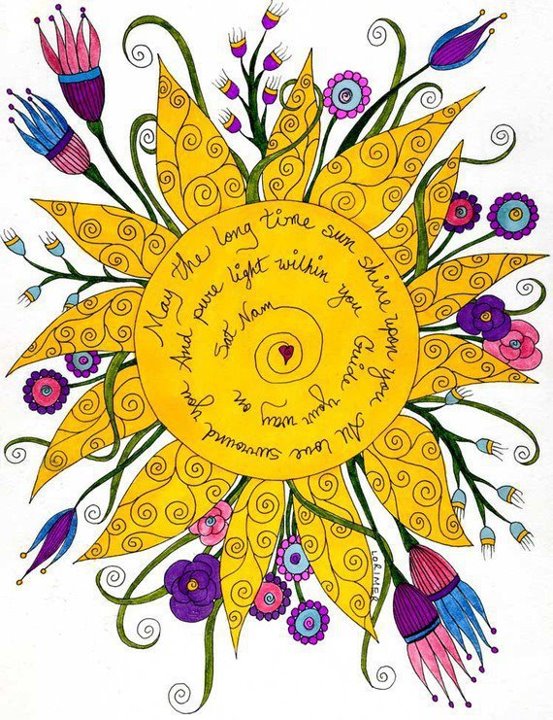Class Format, or What to Expect?
A typical class will last between 60 & 90 minutes. Each class follows a similar structure which is outlined below. Kundalini Yoga is a comprehensive, holistic system and so classes also often include discussions about different aspects of life and lifestyle, nutrition, and spiritual philosophy.
1) Tuning In
A KY class begins with chanting the mantra Ong Namo Guru Dev Namo three times. This is a mantra to honour the Creation and tune into our inner guru, our inner teacher. Chanting the mantra together brings the whole group to a common vibration as the class begins. Ong Namo Guru Dev Namo commonly translates as 'I bow to the Creator, to the Divine Teacher within'. Tuning in with this mantra sets and calms the mind. It also connects us to the 'Golden Chain', the energetic lineage of teachers and students of KY. Following this we chant the mantra Aad Guray Nameh, Jugaad Guray Nameh, Sat Guray Nameh, Siri Guru Dayvay Nameh three times. This is a common KY mantra used for protection. It develops the theme of the guru, the inner teacher, and declares the four stages of time through which the guru prevails; before the beginning, through the ages past, in the present and in the future. Literally it translates as 'I bow to the Primal Wisdom, I bow to the Wisdom through the Ages, I bow to the True Wisdom, I bow to the great unseen Wisdom.'
2) Some Pranayam and Warm-Up Excercises
These are always chosen specifically to prepare the body for the main kriya (yoga set) that will be done in class.
3) Kriya /Yoga Set
The main portion of the class consists of a kriya, a set of prescribed exercises done in a particular sequence and for a specific amount of time to create a desired effect. There are many hundreds of different kriyas, each with their own effect, e.g. detoxifying the kidneys or liver, improving the functioning of a certain organ or the glandular system, strengthening the nervous system, balancing both hemispheres, releasing fears, opening the heart chakra, stimulating the pituitary gland, etc. Every kriya is different, and thus every KY class is different. Some kriyas involve a lot of sitting postures, others involve more ground work (lying down on the stomach and/or the back), still others are mainly done standing. Alternatives for most postures can be provided if you are physically unable to do a certain posture or exercise.
4) Deep Relaxation
After the main kriya there is a period of deep relaxation in savasana or corpse pose (or sometimes on the stomach or in baby pose). Corpse pose and its alternatives allow the body and mind to relax completely, to integrate the effects of the kriya and to let the hormones that have been released by the glands during the kriya, circulate in the bloodstream. The deep relaxation also creates space for rejuvenation of spirit.
5) Meditation
There are literally thousands of different meditations in KY, which all vary in form. Some are done silently, others use various mantras and mudras (hand / arm positions). Each meditation has a particular effect: the promotion of emotional balance or of inner peace, energising the brain, increasing intuition, reducing stress, breaking addictions, strengthening the nervous system, helping one deal with earthquakes or solar flares, etc. The meditations also greatly vary in length: they may be as short as 3 minutes or last as long as 62 minutes.
6) Closing The Class
We finish each class by singing the Long Time Sun Shine Song: ‘May the long time sun shine upon you, All love surround you, And the pure light within you, Guide your way on.’ This song of blessing helps you ground again after the class, helps you integrate the benefits of the yoga and prepares you to resume the activities of everyday life.
Then we chant the manta Sat Naam three times. Sat Naam is a very common mantra used in KY. It means 'In the Name of Truth' ('Sat' means essence or truth, 'Naam' means name or identity). Through chanting it while closing the class we confirm the integrity of the intention with which we have been practicing the yoga class. Sat Naam can also be understood as True Name, or True Identity. As such you state to yourself: 'My True Identity is Naam' which equals 'Infinity', as it refers to the creative vibration from which everything originates and to which everything will return. It is a very good mantra for practicing silently during every exercise - silently vibrating SAT while you inhale and NAAM as you exhale. The long version of Sat Naam is SA TA NA MA, and this is an expression of the soul's journey back home: the sleeping and serpentine consciousness (the Kundalini energy is represented as a snake lying coiled) is awakened from its innate connection to Infinity (SA) through the life of form, of existence (TA) across the daily abyss of death, change, transformation (NA) into an enduring rebirth (MA).
class




